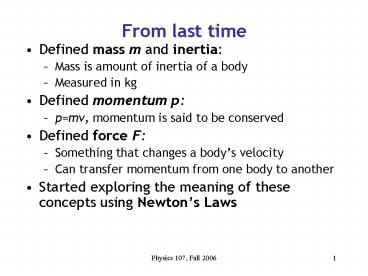From last time - PowerPoint PPT Presentation
Title:
From last time
Description:
Something that changes a body's velocity. Can transfer momentum from one body to another ... slugs!! Physics 107, Fall 2006. 5. Momentum conservation ... – PowerPoint PPT presentation
Number of Views:11
Avg rating:3.0/5.0
Title: From last time
1
From last time
- Defined mass m and inertia
- Mass is amount of inertia of a body
- Measured in kg
- Defined momentum p
- pmv, momentum is said to be conserved
- Defined force F
- Something that changes a bodys velocity
- Can transfer momentum from one body to another
- Started exploring the meaning of these concepts
using Newtons Laws
2
Mass
- Define mass to be the amount of inertia of an
object. - Can also say mass characterizes the amount of
matter in an object. - Symbol for mass usually m
- Unit of mass is the kilogram (kg).
- Said before that
- Find experimentally that
3
Force, weight, and mass
- 1 Newton force required to accelerate a 1 kg
mass at 1 m/s2.
- But then what is weight?
- Weight is a force, measured in Newtons
- It is the net force of gravity on a body.
- Fmg, gF/m
4
Is pounds really weight?
- In the English system (feet, pounds, seconds),
pounds are a measure of force. - So it is correct to say my weight is 170 pounds.
- Then what is my mass?
slugs!!
5
Momentum conservation
- We said before that an impressed force changes
the momentum of an object. - We also said that momentum is conserved.
- This means the momentum of the object applying
the force must have decreased. - According to Newton, there must be some force
acting on that object to cause the momentum
change.
6
Newtons third law
- This is the basis for Newtons third law
- To every action there is always opposed an equal
reaction. - This is momentum conservation in the language of
forces.
7
Newtons laws
- 1st law Law of inertia
- Every object continues in its state of rest, or
uniform motion in a straight line, unless acted
upon by a force. - 2nd law Fma, or aF/m
- The acceleration of a body along a direction is
- proportional to the total force along that
direction, and - inversely the mass of the body
- 3rd law Action and reaction
- For every action there is an equal an opposite
reaction.
8
Example More than one force
a Fnet/M 200N/10kg 20 m/s2
a Fnet/M (200N-100N)/10kg 10 m/s2
9
Colliding balls again
- Before collision
1
2
After collision
1
2
10
Balancing forces
- Force of gravity acts downward on the block.
- But since the block is not accelerating. The net
(total) force must be zero. - Another force is present, which balances the
gravitational force. - It is exerted by the table, on the block.
11
How can the table exert a force?
- The interaction between the table and the block
is a microscopic one.
12
Force of table on block
- The table can compress, bend, and flex by
distorting the atomic positions. - The atomic bond is like a spring and it exerts a
force on the block. - All forces arise at the atomic (or smaller) scale.
13
3rd law Law of force pairs
- Every force is an interaction between two objects
- Each of the bodies exerts a force on the other.
- The forces are equal and opposite
- An action reaction pair.
Force on theblock by you
Force by theblock on you
and the earth!
14
Identifying forces
- If horse exerts force on cart, and cart exerts
equal and opposite force on horse, how can the
horse and cart move?
15
Keep the forces straight!
- For motion of cart, need to identify the net
force on the cart. - Net horizontal force is force from horse,
combined with frictional force of wheels.
16
How can a car move?
Vertical forces
Horizontal forces
Rolling resistance by road on tires
Drive Force by road on tires
Wheels push push backward against the road, Road
pushes forward on the tire
17
Rockets
- I apply a force to a ball for a short time ?t to
get it to move. - During that time, the ball exerts an equal and
opposite force on me! - The forces cause the ball and I to move in
opposite directions
18
Why did the ball and I move?
- The forces resulted in accelerations during the
short time ?t
My acceleration is smaller since my mass is much
larger.
The acceleration changes my velocity.
19
Another explanation
- Before the throw, both the ball and I have zero
momentum. - So the total momentum is zero.
The total momentum is conserved, so after the
throw the momenta must cancel (my
momentum) (ball momentum) 0 (my mass) x (my
velocity) (ball mass) x (ball velocity)
20
Gravitational force
Gravitational force on apple by earth
But mearth6x1024 kg mapple1 kg
21
Equal accelerations
- If more massive bodies accelerate more slowly
with the same force - why do all bodies fall the same, independent of
mass? - Gravitational force on a body depends on its
mass - Therefore acceleration is independent of mass
22
A fortunate coincidence
- A force exactly proportional to mass, so that
everything cancels nicely. - But a bit unusual.
- Einstein threw out the gravitational force
entirely, attributing the observed acceleration
to a distortion of space-time.































